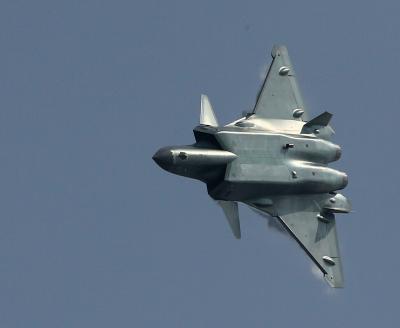Chengdu J-20 Exposes Structural Weaknesses In China's Aerospace Sector: Report
"In appearance it is impressive: a large, long-range twin-engine aircraft with a canard-like planform and internal weapon bays. But a sober look at technical evidence, operational patterns and open-source reporting shows the J-20 is a political and industrial achievement more than a battlefield game-changer. When judged on the core measures that matter in high-end air combat - mature engines, true low observability, avionics/sensor fusion, sustainment and operational doctrine - the J-20 exposes structural weaknesses in China's aerospace sector and in the PLA's rush to modernise," Myanmar-based Mizzima reported.
A modern fifth-generation fighter requires an engine that delivers not only thrust but sustained reliability, thermal management and low maintenance demands. China's struggle to make such an engine is the J-20's most glaring technical Achilles' heel. Early J-20s used Russian AL-31 derivatives or Chinese WS-10 variants, Beijing's domestically developed WS-15 - marketed as the“answer” - has faced numerous delays, concerns over durability and reports of premature wear during endurance tests.
The opinion of people regarding the WS-15-equipped J-20 first developed slowly, and open-source analysts and defence reporting continue to flag uncertainty about how many actual number of operational J-20s using advanced domestic engines compared to inferior substitutes, the report mentioned. These engine problems directly place restrictions on uninterrupted supersonic flights, reduced mission rates, higher maintenance demands, and a vulnerability during extended high-intensity engagements.
Analysts have repeatedly stressed that the J-20's larger airframe compared to F-22/F-35 family designs and its external shaping produce a bigger Radar Cross-Section (RCS) in key features than Western counterparts. Furthermore, PLA deployments and publicised flyovers and accidental imagery leaked to observers have given opponents sufficient baseline data to enhance counter-stealth sensors. In other words, China's haste to 'prove' the platform publicly has reduced the confidentiality that helps true stealth aircraft to maintain an element of surprise. For high-end penetration missions where milliseconds of advantage matter, a greater RCS and predictability of disposition lower the claimed advantages of J-20.
"Open-source reporting and Western technical assessments suggest that while the J-20's sensors are improving, China still lags in fully mature, resilient sensor fusion, networked data integration, and electronic warfare resilience that are battle-proven. Effective sensor fusion requires long experience, a robust software development ecosystem, hardened supply chains and plentiful flight hours across complex scenarios - all areas where China is accelerating but has not yet demonstrated parity with US programs that benefited from decades of iterative combat testing and coalition data sharing. The result: the J-20's situational awareness and contested-electromagnetic-spectrum performance may be less reliable in the fog of real combat than PR messaging implies," Sun Lee, a pseudonym of a writer who covers Asia and geopolitical affairs, wrote in the Mizzima report.

Legal Disclaimer:
MENAFN provides the
information “as is” without warranty of any kind. We do not accept
any responsibility or liability for the accuracy, content, images,
videos, licenses, completeness, legality, or reliability of the information
contained in this article. If you have any complaints or copyright
issues related to this article, kindly contact the provider above.
Most popular stories
Market Research

- New Cryptocurrency Mutuum Finance (MUTM) Raises $15.8M As Phase 6 Reaches 40%
- Bydfi Joins Korea Blockchain Week 2025 (KBW2025): Deepening Web3 Engagement
- Yield Basis Nears Mainnet Launch As Curve DAO Votes On Crvusd Proposal
- 0G Labs Launches Aristotle Mainnet With Largest Day-One Ecosystem For Decentralized AI
- Ethereum-Based Defi Crypto Mutuum Finance (MUTM) Raises Over $16 Million With More Than 720M Tokens Sold
- Fintech's Gender Gap In Focus: Drofa Comms' Women Leading The Way Joins Evolvh3r's She Connects At TOKEN2049






















Comments
No comment